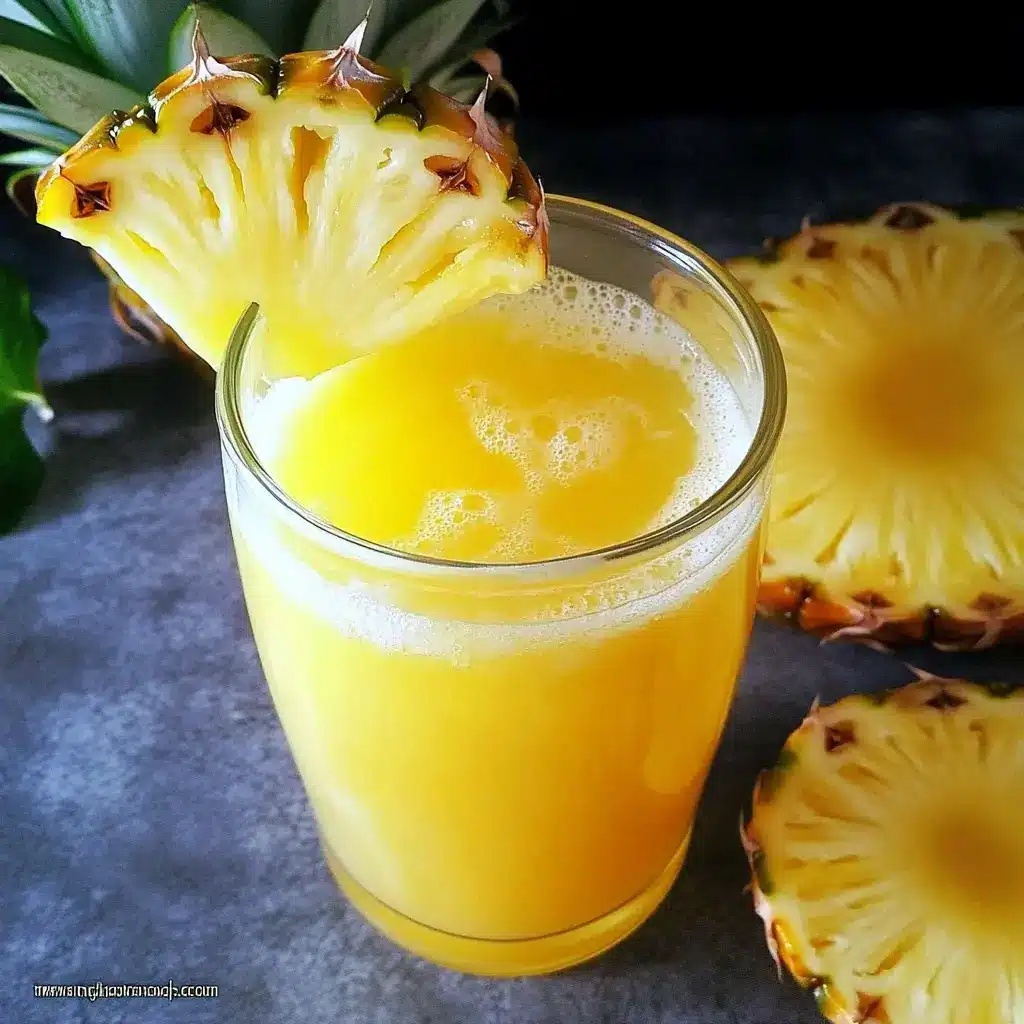Description of this recipe
This vibrant and refreshing Easy Ginger Pineapple Juice is a tropical delight that’s incredibly simple to make and bursting with flavor. Combining the sweetness of pineapple with the spicy kick of ginger and the subtle coolness of mint, all blended with hydrating coconut water, this juice is not only delicious but also packed with health benefits. It’s perfect for a quick morning boost, a revitalizing afternoon pick-me-up, or a light and healthy beverage to enjoy any time of the day. Whether you have a juicer or a blender, this recipe can be adapted to suit your equipment, making it accessible to everyone.
Why you will love this recipe
There are countless reasons to fall in love with this Easy Ginger Pineapple Juice. First and foremost, it’s unbelievably easy to make, requiring minimal ingredients and effort. In just a few minutes, you can whip up a batch of this delicious juice, making it a convenient option for busy individuals and families.
Secondly, the flavor profile is simply irresistible. The tropical sweetness of pineapple is perfectly balanced by the warm, spicy notes of ginger and the refreshing hint of mint. This combination creates a harmonious blend of flavors that tantalizes the taste buds and leaves you feeling refreshed and invigorated.
Moreover, this juice is a nutritional powerhouse. Pineapple is rich in vitamin C, bromelain (an enzyme with anti-inflammatory properties), and antioxidants. Ginger is known for its digestive benefits and anti-inflammatory effects, while mint adds a refreshing touch and aids in digestion. Coconut water is a natural source of electrolytes, making this juice an excellent choice for hydration, especially after a workout or on a hot day.
Another reason to love this recipe is its versatility. You can easily adjust the ingredients to suit your personal preferences. If you prefer a sweeter juice, you can add a touch of honey or maple syrup. If you like a stronger ginger flavor, simply add more ginger. The possibilities are endless!
Finally, this juice is a healthy and guilt-free indulgence. It’s naturally sweet, low in calories, and free from artificial additives and preservatives. It’s a great way to satisfy your sweet cravings while nourishing your body with essential nutrients.
In summary, this Easy Ginger Pineapple Juice is a must-try recipe for anyone who loves delicious, refreshing, and healthy beverages. It’s easy to make, bursting with flavor, packed with nutrients, and incredibly versatile. What’s not to love?
Ingredients:
1x
- ▢ 1 whole Pineapple, washed, peeled, and cut into chunks
- ▢ 2 cups Coconut water
- ▢ 1 inch Ginger, peeled
- ▢ Handful of fresh mint leaves
2x
- ▢ 2 whole Pineapples, washed, peeled, and cut into chunks
- ▢ 4 cups Coconut water
- ▢ 2 inch Ginger, peeled
- ▢ 2 Handfuls of fresh mint leaves
3x
- ▢ 3 whole Pineapples, washed, peeled, and cut into chunks
- ▢ 6 cups Coconut water
- ▢ 3 inch Ginger, peeled
- ▢ 3 Handfuls of fresh mint leaves
Preparation:
Using a Juicer
Step 1: Wash and peel the pineapple. Cut into chunks, including the core. The core is perfectly safe and nutritious to consume, containing a good amount of bromelain. Make sure to remove the skin thoroughly, as it can be tough and bitter.
Step 2: Transfer to the juicer with the ginger and mint. Feed the pineapple chunks, ginger pieces, and mint leaves into the juicer. If your juicer has different speed settings, start with a lower speed for the softer pineapple and gradually increase it as needed.
Step 3: Add coconut water to the collected juice and stir. Once you’ve juiced all the ingredients, pour the coconut water into the collected juice. Stir well to combine all the flavors. The coconut water not only adds hydration but also enhances the overall taste and texture of the juice.
Step 4: Stir and serve with ice cubes in a glass or refrigerate in storage bottles. Give the juice another good stir before serving. Pour it into a glass filled with ice cubes for a refreshing and chilled beverage. Alternatively, you can refrigerate the juice in airtight storage bottles for later consumption. It’s best to consume the juice within 24-48 hours to preserve its freshness and nutritional value.
Using a Blender
Step 1: Follow step 1 above. Ensure the pineapple is properly washed, peeled, and cut into manageable chunks. This will help the blending process and ensure a smooth consistency.
Step 2: Transfer the pineapple, coconut water, mint, and ginger to a blender. Also, cut the ginger into chunks. Place the pineapple chunks, coconut water, mint leaves, and ginger pieces into the blender. Cut the ginger into smaller chunks to facilitate easier blending.
Step 3: Blend until smooth. Blend the ingredients on high speed until you achieve a smooth and consistent mixture. Depending on your blender’s power, this may take a minute or two. If the mixture is too thick, you can add a little more coconut water to help it blend more easily.
Step 4: Transfer to a squeeze bag or cheesecloth and squeeze. Sometimes the pulp will still contain juice, I usually add little water to the pulp, stir and squeeze again to get all the juice out. Place a squeeze bag or cheesecloth over a bowl or pitcher. Pour the blended mixture into the bag or cheesecloth and squeeze out the juice. This step is crucial for removing the pulp and achieving a smooth, clear juice. If the pulp still contains juice, add a little water to the pulp, stir, and squeeze again to extract any remaining liquid.
Step 5: Serve with some ice cubes in a glass and enjoy. Pour the strained juice into a glass filled with ice cubes. Garnish with a sprig of mint or a slice of pineapple for an extra touch. Enjoy your homemade Easy Ginger Pineapple Juice!
COOKING Rating:
Easy
Serving Suggestions:
- Serve chilled with ice cubes for a refreshing drink on a hot day.
- Garnish with a sprig of fresh mint or a slice of pineapple for an elegant touch.
- Pair with light meals such as salads, sandwiches, or grilled chicken.
- Serve as a healthy and refreshing beverage at parties and gatherings.
- Use as a base for smoothies or cocktails.
Tips:
- Use fresh, ripe pineapple for the best flavor.
- Adjust the amount of ginger to suit your taste preferences.
- If you don’t have coconut water, you can use regular water or a combination of water and coconut milk.
- For a sweeter juice, add a touch of honey, maple syrup, or agave nectar.
- Store leftover juice in an airtight container in the refrigerator for up to 24-48 hours.
Prep Time:
10 minutes
Cook Time:
0 minutes
Total Time:
10 minutes
Nutritional Information:
(Note: Nutritional information is approximate and may vary based on specific ingredients and serving size.)
Calories:
Approximately 120-150 calories per serving
Protein:
Approximately 1-2 grams per serving
Sodium:
Approximately 20-30 mg per serving
Conclusion
This Easy Ginger Pineapple Juice is a simple yet delightful recipe that offers a perfect blend of flavors and health benefits. Whether you’re using a juicer or a blender, you can easily whip up a batch of this refreshing beverage in just a few minutes. With its tropical sweetness, spicy kick, and refreshing coolness, this juice is sure to become a favorite in your household. So, grab a pineapple, some ginger, mint, and coconut water, and get ready to enjoy a taste of paradise!
Questions and Answers about this recipe
Q1: Can I use canned pineapple instead of fresh pineapple?
A: While fresh pineapple is highly recommended for the best flavor and nutritional value, you can use canned pineapple in a pinch. However, be sure to choose canned pineapple that is packed in its own juice rather than syrup, as the syrup can add unnecessary sugar. Also, drain the pineapple well before using it in the recipe. Keep in mind that canned pineapple may not have the same level of sweetness and tanginess as fresh pineapple, so you may need to adjust the other ingredients accordingly.
Q2: How can I make this juice sweeter without adding sugar?
A: If you prefer a sweeter juice without adding refined sugar, there are several natural alternatives you can use. One option is to add a small amount of honey, maple syrup, or agave nectar. Start with a small amount (such as a teaspoon) and adjust to taste. Another option is to add a few drops of liquid stevia. You can also add a small piece of ripe banana or a few dates to the blender for natural sweetness and added nutrients. Finally, make sure you are using a ripe pineapple, as riper pineapples tend to be sweeter.
Q3: Can I add other fruits or vegetables to this juice?
A: Absolutely! One of the great things about this recipe is its versatility. You can easily customize it by adding other fruits or vegetables to suit your taste preferences and nutritional needs. Some popular additions include cucumber, carrots, spinach, kale, apples, oranges, and lemons. Experiment with different combinations to find your favorite blend. Just be sure to adjust the amount of each ingredient to maintain a balanced flavor profile.
Q4: Is it necessary to peel the ginger before juicing or blending it?
A: While it’s generally recommended to peel ginger before juicing or blending it, it’s not strictly necessary, especially if you’re using a high-powered juicer or blender. The skin of ginger is perfectly edible and contains many of the same beneficial compounds as the flesh. However, the skin can be a bit tough and fibrous, so peeling it can result in a smoother juice. If you choose to leave the skin on, be sure to wash the ginger thoroughly to remove any dirt or debris.
Q5: How long does this juice last in the refrigerator?
A: This Easy Ginger Pineapple Juice is best consumed fresh, as its flavor and nutritional value will gradually decline over time. However, if you have leftovers, you can store them in an airtight container in the refrigerator for up to 24-48 hours. After this time, the juice may start to lose its flavor and freshness. It’s also important to note that the juice may separate as it sits, so be sure to stir it well before serving. To maximize its shelf life, store the juice in a tightly sealed container to prevent oxidation and contamination.




